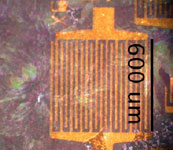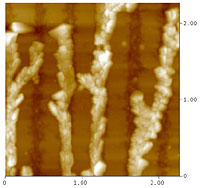
Research Archives Index
Solution-Processed Polycrystalline Tetrabenzoporphyrin Organic Field-Effect Transistors With Nano-structured Channels
Patrick Shea and Jerzy Kanicki
 Tetrabenzoporphryin (TBP) is an organic molecule widely studied in biochemistry, and has a well-understood and controllable synthetic process. While TBP itself is insoluble in most organic solvents, the molecule can be synthesized in a precursor form that allows for solution-processing methods such as printing and spin coating. Upon thermal annealing, the amorphous, insulating precursor film converts to a polycrystalline, semiconducting film. Tetrabenzoporphryin (TBP) is an organic molecule widely studied in biochemistry, and has a well-understood and controllable synthetic process. While TBP itself is insoluble in most organic solvents, the molecule can be synthesized in a precursor form that allows for solution-processing methods such as printing and spin coating. Upon thermal annealing, the amorphous, insulating precursor film converts to a polycrystalline, semiconducting film.
We have shown free-base TBP organic field-effect transistors (OFETs) with field-effect mobilities exceeding 0.01 cm2/V-s, while maintaining low sub-threshold slopes (≈1 V/dec), low OFF-state currents (≈10 pA), and moderate threshold voltages (-20 V > VT > 0 V). While TBP OFET performance is susceptible to ambient exposure, we have demonstrated a novel packaging method to enhance device lifetime.
The transfer characteristics of TBP OFETs demonstrate a remarkable degree of linearity compared to other solution-processed OFETs, with field-effect mobility being constant over a wide range of VGS. With its polycrystalline thin-film morphology, this indicates band-like transport. To better understand this aspect of TBP electronic behavior, we are studying the band-structure of TBP using various quantum mechanical models, and have found a close relation between experimental and computational results.
 While free-base TBP produces excellent OFET behavior, OFET performance is limited by crystallization and molecular packing. In collaboration with Ehime University (Japan), we have studied the thin-film morphology and electronic performance of metal-substituted TBP. Significant variations in morphology are observed, as well as several orders of magnitude enhancement in electrical performance. To date, we have observed field-effect mobilities as large as 0.6 cm2/V-s and crystals with diameters on the order of 1 mm, all from OFETs using solution-processed films. While free-base TBP produces excellent OFET behavior, OFET performance is limited by crystallization and molecular packing. In collaboration with Ehime University (Japan), we have studied the thin-film morphology and electronic performance of metal-substituted TBP. Significant variations in morphology are observed, as well as several orders of magnitude enhancement in electrical performance. To date, we have observed field-effect mobilities as large as 0.6 cm2/V-s and crystals with diameters on the order of 1 mm, all from OFETs using solution-processed films.
We also show that thermal conversion of the precursor film to TBP can be enhanced by ordered TBP aggregation in the pre-patterned nanometer-scale trenches, demonstrating precise control and placement of long- and short-range ordering of the organic semiconductor. Thin-film transistor (TFT) with such nano-structured channels shows one order improved electrical performance in comparison with regular TFTs. We envision the results of these studies leading to sensitive organic biochemical sensors and easily fabricated organic circuits on plastic substrates.
P.B. Shea, C. Chen and J. Kanicki, Appl. Phys. Lett., 90, 233107, 2007; and P.B. Shea, L.R. Pattison, M. Kawano, C. Chen, J. Chen, P. Petroff, D. Martin, H. Yamada, N. Ono and J. Kanicki, Synthetic Metals, 157, 190, 2007.
top
|

